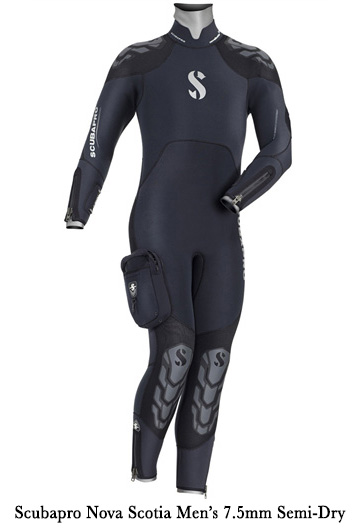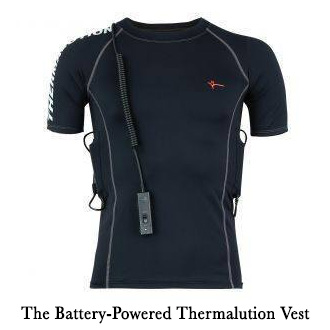What Wetsuit Should You Get?Contents of this Issue: Serious BC Issues: A Mares Recall, and a Major Design Flaw Red Tide Is Gone, But Here Is Florida’s New Coastal Threat Splash Inn Dive Resort, Roatan Send Your Reader Reports (And Tell Us About Plastic Use) Why You Had Better Confirm Your Flight Itinerary Technical Diving: Is It For You? The “Canaries of the Reef” Are in Trouble Sidemount Diving: Take that Weight off Your Back Lessons from My Wife’s Snorkeling Death Maybe This Is the Reason Why His Wife Drowned Old Dive Computers, Odd Treatment: Letters to the Editor A Catastrophic Regulator Failure Editorial Office: Ben Davison Publisher and Editor Undercurrent 3020 Bridgeway, Suite 102 Sausalito, CA 94965 the right choices for keeping warm in the water from the April, 2019 issue of Undercurrent
New divers often ask on social media for advice on which wetsuit to buy. However, everyone has different requirements subject to their body mass -- and their own expectations. What can't be denied is that water conducts heat away from you many times faster than air of the same temperature. Even diving in tropical seas at what appears to be bathwater temperatures, you will eventually get cold.
So what is the right suit for you? Here are a few things to keep in mind next time you're shopping around. Lycra suits are merely to protect against maneating plankton; they offer no insulation whatsoever. They are more often now called rash guards because they guard against getting a skin rash from sea itch. The more expensive ones, like the Scubapro T-Flex, are lightweight, quick-drying garments that provide UVF-80 certified rating protection against sunburn and ultraviolet rays. Wetsuits generally come in three different thicknesses -- 3mm, 5mm and 7mm. It's the integral bubbles of nitrogen that provide the insulation, so it`s important not to leave a suit out in direct sunlight, because these bubbles will expand and burst and the insulation will be less effective. Avoid creasing your wetsuit for the same reasons -- store your suit on a hanger and roll it rather than fold it when packing for a trip. The thinner the suit, the easier it is to pull it on and off, but a suit needs to fit like a coat of paint, with only a skin of water between you and it, to work well. Divers used to disappear in a cloud of talcum powder when they fought their way into their wetsuits, but the modern (and more expensive) neoprenes are much more flexible. Good examples come from Waterproof and Fourth Element in both 3mm and 5mm, while all major manufacturers offer suits bearing their own brand. Some have a fleecy lining over the torso area for added insulation -- O'Neill calls theirs a firewall. Overall, the best suit is the one that fits you perfectly. Look for suits that have seals at wrists and ankles to reduce the chance of water flushing where the suit is not a close fit. There are times when 5mm is not enough. The chilly waters of the Galapagos, for example, may call for a 7mm semi-dry, like a Scubapro Nova Scotia. With latex seals at neck, wrists and ankles, and a drysuit-style zip, it keeps flushing to a minimum. Such a suit is also good for use in the waters of Northern California and above. Because it's a "semi-wet" rather than a semi-dry, that moment after you climb out of such a suit is when you might suffer discomfort. However, many of us divers make do with a 5mm wetsuit, so it's a good idea to add an extra layer to it if you need to. It's not just a great strategy for Arctic explorers; it works equally well in non-frigid conditions. You could wear a shorty over the top, or a neoprene vest underneath your 5mm suit. The problem is that as you add more neoprene, you need to add more weight to counter its inherent buoyancy. There are tops made from a high-tech fabric (Sharkskin and Thermocline are two brands) that is neutrally buoyant, so you don't need to add any weight. It's also hydrophobic, so it doesn't get wet. Some divers make do with nothing more than that. Others swear that a thick hood makes a difference, especially one notable dive guide in St. Croix who only wears a hood along with his Speedos (although he does tend to look like a character out of Pulp Fiction). Stitching is the weakest point of any wetsuit. Seams need to be blind-stitched and glued to avoid the stitching causing penetrating holes in the fabric, and good suits have the stitching reinforced. Higher-end O'Neill suits use fluid seamwelding over the stitching for strength.
If you have a drysuit that fits snugly, you could always wear it in warmer conditions, but with a minimum layer of insulation underneath. Many dive guides in the northern Red Sea do this in the earlier months of the year, when the water is warm enough but the wind bites. It's climbing out of a wetsuit after a dive that become uncomfortable in those conditions, making many divers rush to a warm shower under which they can disrobe without teeth chattering. Divers in drysuits impart an air of superiority as they step out from their suits, dry and already dressed for dinner. If you`ve taken a wetsuit that is thicker than necessary for your dive destination, you can always wear it with the top half wrapped around your waist when you are out of the water. But if you've taken a suit that is insufficiently warm in the water, there's precious little you can do about it, apart from attempt to beg, borrow or rent an extra layer (please don't steal one from your fellow diver). Wearing gloves does little to keep you warm if your body core is losing heat. It's worth comparing notes with other Undercurrent subscribers who write reader reports of the dive destination you're headed to, but bear in mind their expectations might be different to yours. A "more is more" motto is best when it comes to packing what you'll be wearing while diving -- getting cold will discourage you from doing as many dives as you might do otherwise and make for a less-than-stellar dive trip. -- Ben Davison |

I want to get all the stories! Tell me how I can become an Undercurrent Online Member and get online access to all the articles of Undercurrent as well as thousands of first hand reports on dive operations world-wide
| Home | Online Members Area | My Account |
Login
|
Join
|
| Travel Index |
Dive Resort & Liveaboard Reviews
|
Featured Reports
|
Recent
Issues
|
Back Issues
|
|
Dive Gear
Index
|
Health/Safety Index
|
Environment & Misc.
Index
|
Seasonal Planner
|
Blogs
|
Free Articles
|
Book Picks
|
News
|
|
Special Offers
|
RSS
|
FAQ
|
About Us
|
Contact Us
|
Links
|
3020 Bridgeway, Ste 102, Sausalito, Ca 94965
All rights reserved.

 You might have noticed dive guides wearing
more insulation than you. That's because repeat
diving (often on dives typically lasting longer
than yours), combined with acclimatization to
warm air temperatures, makes them more susceptible
to getting cold. You might be happy diving
in nothing more than a Lycra skin, while your
dive guide wears a 5mm thick suit. Well, nobody
has ever called a dive because they got too hot in
the water.
You might have noticed dive guides wearing
more insulation than you. That's because repeat
diving (often on dives typically lasting longer
than yours), combined with acclimatization to
warm air temperatures, makes them more susceptible
to getting cold. You might be happy diving
in nothing more than a Lycra skin, while your
dive guide wears a 5mm thick suit. Well, nobody
has ever called a dive because they got too hot in
the water. The latest strategy for divers is to wear a heated
vest under a thinner wetsuit. Don't confuse these latest inventions with the bulky devices
designed for drysuits that run from big battery
packs. The new Thermalution vests are of a
stretchy material and employ far-infrared technology
to warm your core blood -- you won't feel
the vest getting hot, but your exposed peripheries
will stay warm in the coldest water. Running on
small, nonintrusive rechargeable battery packs,
Thermalution vests are designed to work even
while wet, so while most buyers intend to use
them with drysuits in the coldest conditions, they
work equally well with wetsuits. They're expensive,
but you could get your money back by saving
on excess baggage fees.
The latest strategy for divers is to wear a heated
vest under a thinner wetsuit. Don't confuse these latest inventions with the bulky devices
designed for drysuits that run from big battery
packs. The new Thermalution vests are of a
stretchy material and employ far-infrared technology
to warm your core blood -- you won't feel
the vest getting hot, but your exposed peripheries
will stay warm in the coldest water. Running on
small, nonintrusive rechargeable battery packs,
Thermalution vests are designed to work even
while wet, so while most buyers intend to use
them with drysuits in the coldest conditions, they
work equally well with wetsuits. They're expensive,
but you could get your money back by saving
on excess baggage fees.